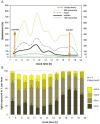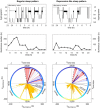Living in Biological Darkness II: Impact of Winter Habitual Daytime Light on Night-Time Sleep
- PMID: 39831471
- PMCID: PMC11744753
- DOI: 10.1111/ejn.16647
Living in Biological Darkness II: Impact of Winter Habitual Daytime Light on Night-Time Sleep
Abstract
Timing and architecture of sleep are co-driven by circadian rhythms modulated by their major Zeitgeber light and darkness. In a natural environment, one is exposed to 3.000 lx (cloudy winter sky) to 100.000 lx (bright sunny sky). The aim of the study was to assess (1) habitual daytime light exposure in urban winter and (2) impact of daytime urban light on objective night-time sleep. Eleven healthy participants (mean age ± SD: 25.4 ± 2.8 years; 6 male) wore eyeglass frames continuously recording daytime illuminance levels vertically to the eye by mounted sensors (range: 1-40.000 lx) during four consecutive days in winter 2008 in Berlin, Germany. In-lab polysomnography was performed over two nights in nine participants. Median light exposure over 4 days was the following: full day 7:00-19:00 h: 23 lx (12-37 lx); morning 7:00-11:00 h: 81 lx (19-201 lx); midday 11:00-15:00 h: 68 lx (19-164 lx); afternoon 15:00-19:00 h: 22 lx (6-58 lx), resulting in only 36 min > 500 lx per day. Timing of daytime light intensity was significantly associated with subsequent sleep: lower midday illuminance with shorter REM latency (Rho = 0.817; p = 0.049) and earlier REM polarity (less prevalence of REM at end-of-sleep; Rho = 0.817; p = 0.049). Humans, living in an urban environment, appear to be exposed to extremely low light levels, which we named as 'Living in Biological Darkness'. Most fascinating, physiology seems to adapt and responds to variation in light intensity on such low levels. Interestingly, the observed changes in sleep architecture with low light levels are reminiscent of those suspected to constitute biological markers of depression some 40-50 years ago.
Keywords: REM latency; SWS; biological darkness; depression marker; habitual daytime lighting; sleep.
© 2025 The Author(s). European Journal of Neuroscience published by Federation of European Neuroscience Societies and John Wiley & Sons Ltd.
Conflict of interest statement
The authors declare no conflicts of interest.
Figures



Similar articles
-
Human seasonal and circadian studies in Antarctica (Halley, 75°S).Gen Comp Endocrinol. 2018 Mar 1;258:250-258. doi: 10.1016/j.ygcen.2017.05.010. Epub 2017 May 17. Gen Comp Endocrinol. 2018. PMID: 28526480
-
Bright-light exposure during daytime sleeping affects nocturnal melatonin secretion after simulated night work.Chronobiol Int. 2018 Feb;35(2):229-239. doi: 10.1080/07420528.2017.1394321. Epub 2017 Nov 16. Chronobiol Int. 2018. PMID: 29144169
-
Daytime naps in darkness phase shift the human circadian rhythms of melatonin and thyrotropin secretion.Am J Physiol Regul Integr Comp Physiol. 2000 Feb;278(2):R373-82. doi: 10.1152/ajpregu.2000.278.2.R373. Am J Physiol Regul Integr Comp Physiol. 2000. PMID: 10666138
-
Biological rhythms during residence in polar regions.Chronobiol Int. 2012 May;29(4):379-94. doi: 10.3109/07420528.2012.668997. Epub 2012 Apr 12. Chronobiol Int. 2012. PMID: 22497433 Free PMC article. Review.
-
Effect of seasonal changes in daylength on human neuroendocrine function.Horm Res. 1998;49(3-4):118-24. doi: 10.1159/000023157. Horm Res. 1998. PMID: 9550111 Review.
References
MeSH terms
Grants and funding
LinkOut - more resources
Full Text Sources
Miscellaneous

